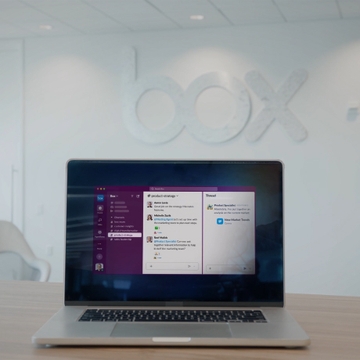When you’re face to face with 1.25 pounds of Maine lobster plated on a buttery bed of garlic noodles, you’ll agree that Lobsterdamus’ signature “Lobster Nest” dish is nothing short of Instaworthy. It’s why this mobile food concept is a crowd favorite at Off the Grid’s flagship Friday night market at Fort Mason Center.
A San Francisco-based mobile food network, Off the Grid serves over 75,000 meals each week across 20 locations in the Bay Area. In addition to feeding the lunch, dinner and weekend brunch crowds, Off the Grid offers corporate and private-event catering services.
More than 300 people work for Off the Grid, and most days about 200 staff members are distributed across the various event locations. Coordinating this many food creators and employees means Off the Grid is always balancing lots of spinning plates, and Slack is there to lend a hand.
How Slack logistically helps a growing food industry
These days, food trucks go hand in hand with city plazas, parks and outdoor festivals. While it may be hard to remember a time without these cheery, colorful carts and trucks, the mobile food movement has its roots in the recession of the late 2000s.
“Slack helps us communicate with our operations teams out in the field so we can get real-time updates very quickly, easily and seamlessly. We use it to keep high-level conversations moving and day-to-day operations afloat.”
According to Off the Grid’s industry report released late last year, “Think Mobile, Act Local: The Future of Mobile Food in America,” the recession left many chefs and restaurant workers unemployed as traditional brick-and-mortar restaurants shuttered. In 2008, the owners of Kogi BBQ decided to put their business on wheels and tweet out their location to customers throughout Los Angeles.
Over the next decade, the mobile food movement spread across the country, from Portland, Oregon, to Philadelphia. Off the Grid entered the scene in 2010 with its Fort Mason Center market. As the company grew, it started using Slack to keep the wheels in motion, from culinary quality control to emergency response.
“Slack helps us communicate with our operations teams out in the field so we can get real-time updates very quickly, easily and seamlessly,” explains Stephanie Kuo, Off the Grid’s director of culinary innovation. “We use it to keep high-level conversations moving and day-to-day operations afloat.”
At each site, Off the Grid’s market hosts perform the role of restaurant floor manager. Computers aren’t portable enough for Off the Grid team members out in the field, so they use their mobile Slack apps to keep in touch.
Off the Grid hosts also create a Slack channel—a single place for a team to share messages, tools and files—to handle logistics. These employees set up equipment, take stock of inventory and address staffing concerns. Once setup is complete, the hosts use Slack to send photos of the site to their teammates at headquarters. If anything is amiss, the market hosts can quickly troubleshoot and problem solve with headquarters.
Quality control: Slack’s role as chef’s assistant
Everyone knows what happens when there are too many cooks in the kitchen, so Off the Grid’s internal culinary team—which provides daily mobile food service for large corporate clients—uses Slack to test creative concepts and check for quality control. The same way that restaurants run preservice lineups, Off the Grid’s culinary team uses its #PreServiceLineUp channel to review photos of each dish.
“We have our cooks post photos of all the dishes before they execute service, so we can spot-check from afar,” explains Lindsey Newton, Off the Grid’s chief financial officer.

According to Newton, these photos offer critical information about portioning, sauce consistency and presentation.
“Those are things we can identify and correct from afar,” she says. “We’ll see the photo, comment on it, and then the cook on the truck can take that feedback and either post another photo or we’ll have one of the managers onsite do an actual quality check.”
Coordinating swift emergency responses with Slack
When the Tubbs Fire ripped through Northern California in 2017, Off the Grid used Slack to support first responders. The company set up a #DisasterSupport channel and coordinated teams to travel to the area with food and supplies.
On a day-to-day basis, Off the Grid maintains a safety channel so appropriate teammates can quickly respond to any accidents that happen on the job.
“We have so many vehicles, assets and employees out in the field,” Newton explains. “There’s always going to be someone who will be there to respond if something happens.
As a company founded on the principles of sharing good food in good company—and being in community—Off the Grid employees use Slack to have fun too. Social channels like #random, #active-otg and #discovery-moments help the team coordinate outings, share articles and recipes, and motivate each other to stick with those group fitness classes. It’s also their go-to place for sharing and discussing the internet’s menagerie of cute animal content.
“My favorite Slack channel is called #CatLoversGalore,” Kuo says. “We post pictures of our cats or cute cats from social media. When we discover another cat lover in the office, we add them to the group. They have to get invited; it’s a secret,” Kuo says with a laugh, then adds, “Well, I guess not anymore.”















